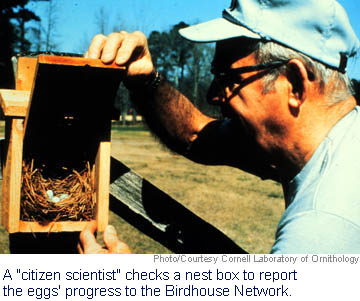Dispatch No Degree Required - Feb. 19, 2000
By Lisa Strong
Can you contribute to science without a Ph.D.?
"Amateurs make the greatest contributions to paleontology, " said New Mexican paleontologist Adrian Hunt. Paleontology is the study of the traces of ancient life. Traces is the key word: only about 2 percent of species have ever become fossils. Because they're so few and far between, individual can be veritable Rosetta stones to paleontology.
"We need lots of eyes to help look," said Hunt. Through a program called "Fossil Friends," offered through the museum at Mesa Technical College in New Mexico, Hunt leads teams of amateurs on fossil digs. While they hunt for scarce bones, the amateur paleontologists also pick up professional skills from Hunt. A good argument, but one ornithologist begged to differ.
"The greatest contribution is made in ornithology," insisted Rick Bonney of the Cornell Laboratory of Ornithology. In the U.S. alone, there are 60 million. The pros can't be everywhere at once, so they rely on what Bonney has termed "citizen scientists."
The citizen scientist programs at Cornell have compiled data from across the nation and Canada through amateur participation in the Birdhouse Network, Project FeederWatch, and Project PigeonWatch to name a few. The programs are on the Internet, and resulting distribution maps are updated hourly.
The data collected by amateurs even make it into scientific journals. The results have also been used to help shape conservation decisions, an issue that Bonney and his leagues of citizen scientists really care about.
Then the astronomers weighed in.
Amateurs swell the ranks of people watching the night sky. There are only 10,000 professional astronomers in the world, but hundreds of thousands of amateur astronomers. Consumer technology is helping the field of astronomy tremendously by making high-powered, precise, and more commonly, automated telescopes for $1000 and less.
Digital imaging equipment now available to amateurs make pictures that "look like Hubble Space Telescope images," said Fienberg only slightly joking. Couple this with the fact many small mountain-top telescopes are closing due to belt-tightening, and you get professionals increasingly depending on amateurs for observations.
Because amateurs are so important to all three disciplines, scientists actively court them. Professional paleontology and astronomy meetings often invite amateurs to attend, even helping defray the costs. The Cornell Laboratory of Ornithology programs educate and recruit new citizen scientists, and get involved with schools, clubs, and other organizations.
Fienberg characterizes amateurs as, "eager, willing and capable to contribute to science." Paleontology, ornithology, and astronomy are particularly open to the contribution of amateurs since, rocks, birds and the stars are accessible to most everyone. "You don't need a Ph.D. to recognize the constellations," said Fienberg. The only field that didn't particularly care for amateurs was chemistry. Amateurs in chemistry are either locked up or have blown themselves to bits," commented Fienberg.
|
The museum of science, art, and human perception
©2000 The Exploratorium

 A fossil-hunting paleontologist, a bird-chasing ornithologist, and the publisher of Sky & Telescope magazine answered a resounding YES at a session Friday morning. There was even a friendly scuffle about just which field of science benefits the most from amateurs.
A fossil-hunting paleontologist, a bird-chasing ornithologist, and the publisher of Sky & Telescope magazine answered a resounding YES at a session Friday morning. There was even a friendly scuffle about just which field of science benefits the most from amateurs.
 Richard Tresch Fienberg, head of Sky Publishing Corporation, made a case that amateurs are vital in making many important astronomical observations and even new discoveries.
Richard Tresch Fienberg, head of Sky Publishing Corporation, made a case that amateurs are vital in making many important astronomical observations and even new discoveries.